The 1985 Alchimia Manifesto proclaims, "Per Alchimia le discipline non interessano quando sono considerate al l’interno delle loro regole", 'For Alchimia, disciplines are of no interest when considered within their rules', rather, and much as the alchemists of yore advanced, "è importante indagare nei grandi spazi liberi esistenti fra di essere"1, 'it is important to explore the vast free spaces existing between them'.
With Alchimia. The Revolution of Italian Design the Bröhan Museum, Berlin, take you into those "grandi spazi liberi" as explored by the Alchimisti of Atelier Alchimia.......
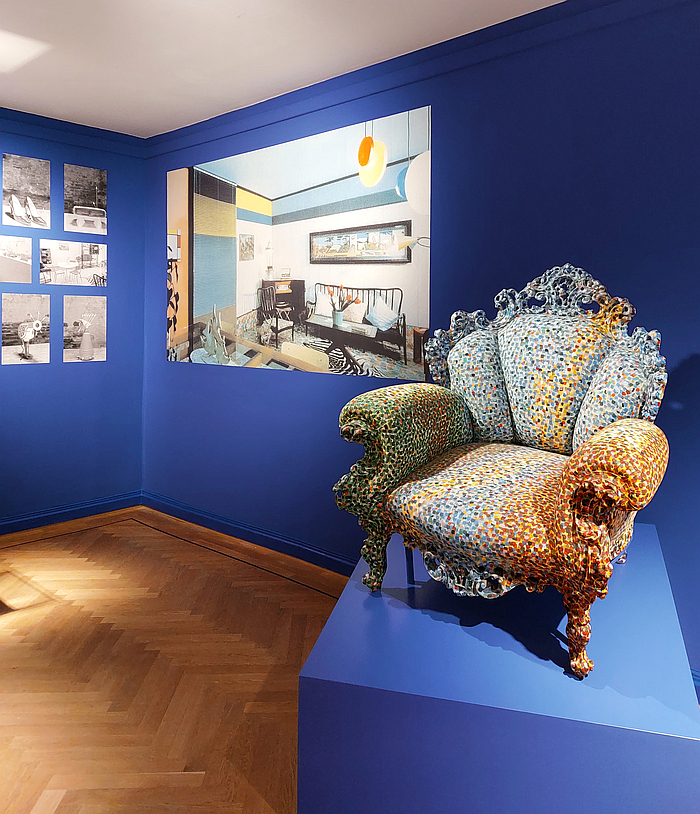
Established in Milan in 1976 by siblings Adriana and Alessandro Guerriero, Alchimia's genesis is rooted very much in context of the Radicalism in, and of, architecture and design in the contemporaneous Italy; a Radicalism that, in many regards, was a product of the social and cultural implosions of the late-1960s combined with the economic and political realities of 1960s Italy, and the associated novel definitions of the terms 'architecture' and 'design', and novel positions on architecture and design's relationships with individuals and societies, such implosions and realities stimulated and advanced.
A Radicalism with which Alchimia. The Revolution of Italian Design, essentially, opens with a brief introduction to key moments in the development of Italian Radicalism, including, for example, Superstudio's 1969 Monumento Continuo, that endless raster which flows as an unyielding straight line across the surface of the earth thereby negating both architecture and urban planning; the early 1970s Global Tools platform which sought, and summarising more than is perhaps advisable, a greater influence of artisan production on goods of daily use akin to that which a William Morris had demanded a century earlier; or Riccardo Dalisi's Technica Povera which, as with the Arte Povera from which it can be considered related, sought to employ simple, unsophisticated, often found, materials as the basis for objects all could realise and thereby to enable an increased sense of empowerment within communities.
A setting of the scene in mid-1970s Italy from which The Revolution of Italian Design moves off to a discussion on and approaching of Alchimia in the course of 10 succinct chapters that initially run chronologically, thereby enabling one to better appreciate the motivations, influences and developments of and within the platform, before becoming more thematic in nature, and thereby taking one deeper into the agency, relevance and legacy of Alchimia.
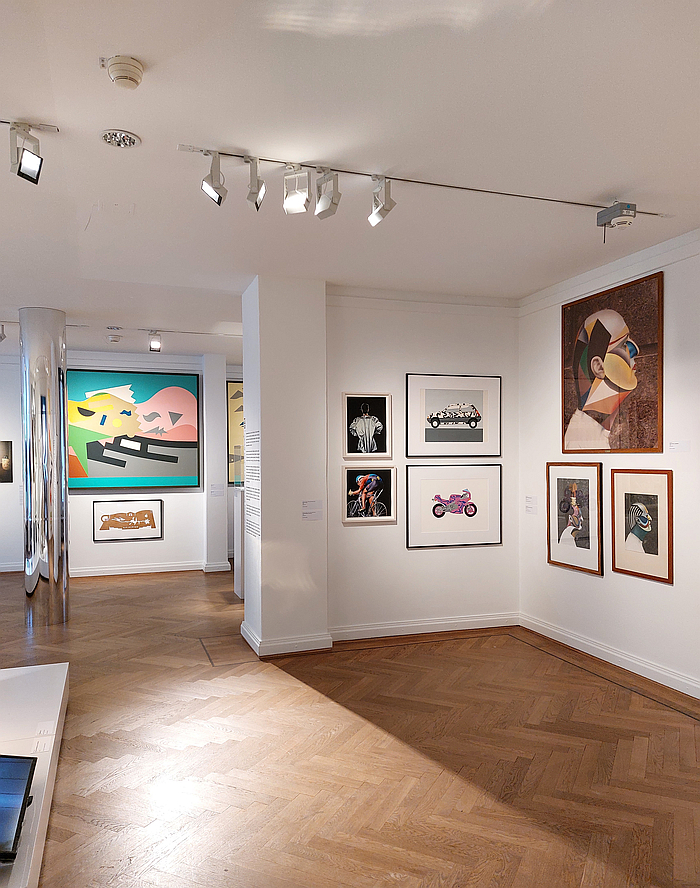
A chronology that opens, as essentially the (hi)story of Alchimia opens, with the Ars Aurica collection from 1976-78, a, in principle, reduced, classically practically functional furniture collection that includes the Tavola Ultima Cena, Last Supper Table, a proactively named, and presented, table in über-Catholic Italy, claiming as Alchimia do that dinners with 13 guests tend to end badly, therefore they have designed a table that can seat a maximum of 12; specifically, a foldable, transportable, storable table for 12, and thus a table that is very much in keeping with thoughts on temporary furniture, and temporary architecture that, and as discussed in context of, for example, the Gabriella Chair by Gio Ponti for Walter Ponti, were a central feature of the late 1960s in which Alchimia began approaching their alchimia. The question in how far a Gio Ponti can be considered a Radicale, or a proto-Radicale, is one for another day.
An Ars Aurica collection, a debut Alchimia collection, that the 1978 Banal Design collection, in effect, questioned, much as it questioned many of the positions and approaches inherent in design as practised and understood by previous generations, questioned positions and approaches to design that made an Ars Aurica collection possible and plausible. A Banal Design collection that is anything but Banal, embellishing, elaborating, disrupting, as it does everyday objects of 1970s Italian life with colour and appendages that speak of a naive invented folk art; an approach that as the curators note was informed by ideas of kitsch, a questioning, if one so will, of the primacy of the academic inherent in architecture and design much as previous generations had questioned the academic inherent in art. Thus a kitsch, a claimed banality, that helps underscore the influence of Technica/Arte Povera on Alchimia and the Alchimisti. And thus also indicates a principle of democratisation through design practice inherent in the work of Alchimia.
And a Banal Design collection that includes Alessandro Mendini's 1978 Poltrona di Proust, superficially an 18th century armchair treated in the 19th century Pointillism of a Paul Signac, a work that, as noted from Mondo Mendini at The Groninger Museum, Groningen, not only stands proxy for the wider influence of Pointillism on Mendini's positions and oeuvre, nor only embodies the way the contemporary invariably, inexorably, swathes the past to deny it its form and materiality, nor only, much as the Pointillists deconstructed landscape painting and thereby our perspective on the world around us, represents that task to "ridisegnare incessantemente l’immagine del mondo", "incessantly redrawing/retracing/redesigning the image of the world"2 Alchimia claimed for itself in its Manifesto, but a Poltrona di Proust which also poses questions of decoration and ornamentation. Questions to which we shall return.
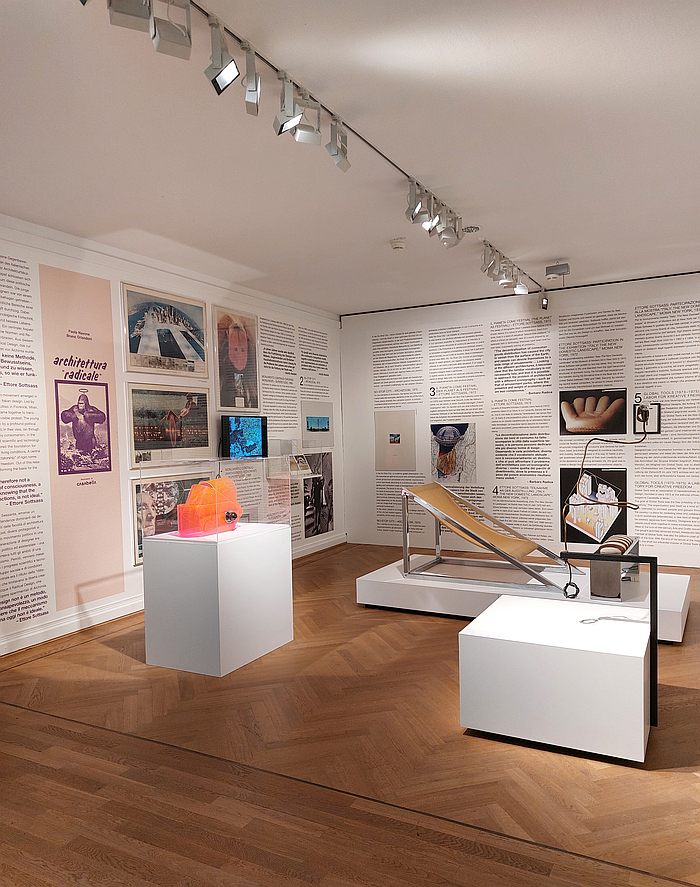
And a Poltrona di Proust that in many regards stands in the Bröhan Museum as a segue to the 1978 Alchimia project, 1978 Alessandro Mendini project, Redesign with its, well, redesigns, of some of the key moments in the (hi)story of (European) furniture design including Gerrit T. Rietveld's Zig-Zag chair, Gio Ponti's Superleggera or Marcel Breuer's B3 a.k.a. the Wassily Chair, the latter presenting itself with leather seat, armrests and backrests in patches of multi-coloured leather, somehow reminiscent of military camouflage, and which flow and curve outwith the dogmatic, functional quadratic constraints of Breuer's black leather. And that in a manner that wouldn't set it out of place, physically or conceptually, in Mehr als echt (More than real) by Jun Yang at Stiftung Bauhaus Dessau, as a work that poses those questions posed by Jun Yang of if one can alter works by Bauhäusler, for all the scared artefacts of Bauhaus such as the Wassily Chair.
A question in many regards also inherent in, or perhaps more accurately a questioned answered by, the Alchimia Manifesto's position that "tutto quanto accadrà è già avvenuto", 'everything that will happen has already happened', albeit while 'for Alchimia, memory and tradition are important', 'the new drawing/tracing/design is autonomous from any rhetorical concession': it may have happened, but it shouldn't be repeated. An alternative take on, a reformulating, one could argue a tightening of, a Kaare Klint's "Problemerne er ikke saa nye, de er i mange Tilfælde løst før"3, 'the problems are not so new, they have in many cases been solved before' and which further admonishes the importance of looking to, and critically questioning, the past as a navigation tool on the path forward. Without repeating that past. That's gone.
A questioning of the past in context of the present and the future also very much inherent in the two Bau.Haus collections from 1979 and 1980, two collections, not uninterestingly, and digressing briefly, if necessarily, from the subject at hand, presented at a period when the Bauhauses existed in a state of popular anonymity, were terms for specialists but not for not a mass public, were sober, unostentatious, if respected, serious, moments in the (hi)story of architecture and design and not the objectificated fantasy kingdoms of today, and which poses the question in how far the questioning of Bauhauses by post-1968 architecture and design was at least partly responsible for the rise of the Bauhauses to their contemporary unsustainable mythologising... but that is all a discussion for another day...
...two Bau.Haus collections in which creatives such as, for example Michele De Lucchi, Andrea Branzi or Ettore Sottsass play less with the objects of the Bauhauses as with the tenets of international Functionalist Modernism the Bauhauses popularly stand proxy for, in its various dialects. Developing thereby objects that while containing, more or less, identifiable principles of the 1920s and 30s, identifiable approaches and positions of the 1920s and 30s, corrupt them, embellish them, align them with popular culture rather than avant-garde culture, alienate them, kitsch them, conceptually swathe the positions of the past to deny them their identity, their agency, and through challenging the primacy of those tenets question the relevance and validity of Functionalist Modernism.
Thus collections that stood and stand as a component of both that moving post Modernism and that further development of Modernist principles in a period post their genesis that occurred in the 1970s and 80s in a variety of contexts and expressions. And which today are lazily lumbered together as the 'Postmodern' we've stopped using since viewing Everything at Once: Postmodernity, 1967–1992 at the Bundeskunsthalle, Bonn. But a 'Postmodern' a lot of people will use when viewing The Revolution of Italian Design. Indeed we suspect it will be the most regularly used word amongst visitors.
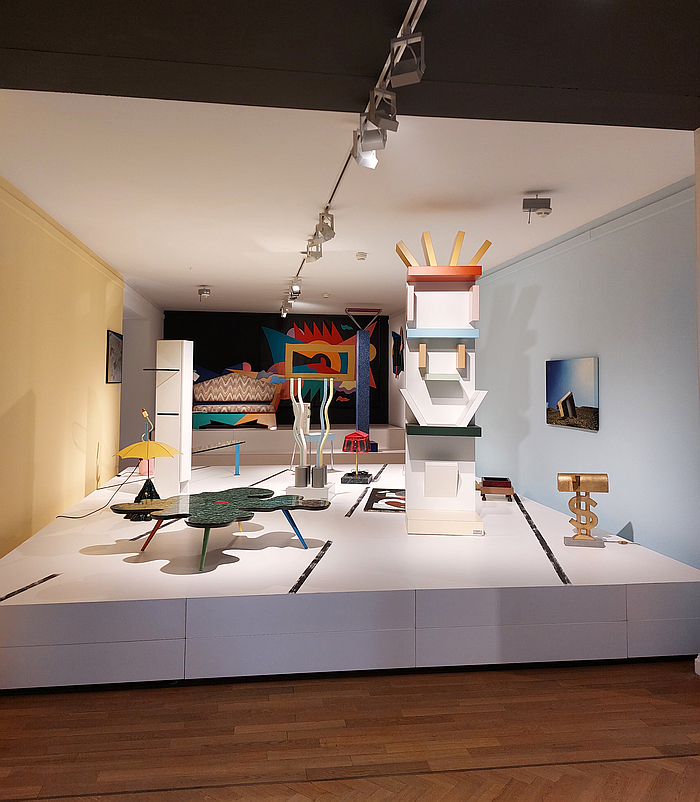
The chronological section of The Revolution of Italian Design ends with the 1984 project Zabro and the 1988 project Ollo. The former a, in essence, brand established between Alchimia and Zanotta and which marks an attempt at a move away from the small scale artisan production of the earliest years and towards a greater technical sophistication. And arguably professionalisation of supply and distribution that, presumably, was intended to ensure a degree of monetisation of the developments of the past decade. And a collaboration with Zanotta which reminds, and amongst other possible examples, that Artemide essentially pay-rolled Memphis, and that without Olivetti untold Radicals and their ilk would have starved before they could have influenced the future; thus helping underscore the importance of not only thinking commercially as a design focussed brand but also thinking culturally. Remembering that, certainly in terms of furniture, commerce and culture exist in a vital interdependency, without the one there cannot be the other, and that as a commercial concern, certainly a concern who seek to profit from furniture, or trainers, fostering and supporting culture, providing opportunities for cultural development, is fundamental in ensuring your survival. That simply exploiting a culture that is unable to defend itself, in the name of commercial gain, is commercially unsustainable. And culturally unjustifiable.
The latter a project that sought to create a uniformity across a variety of objects through the repeated use of a limited decorative vocabulary; decoration, ornamentation, to which, as previously promised, we shall return. And an Ollo project that was realised just before the global implosion of 1989, an implosion that, much as that of 20 years earlier had enabled, empowered, Alchimia, in many regards, and as previously discussed from 1989 – Culture and Politics at The National Museum, Stockholm, brought an end to the exponentially increasing fervour of the past two decades, and demanded a sober rethink across all aspects of society. A 1989 that while it didn't see the demise of Alchimia per se, an Alchimia can demise as easily as a Bauhaus or a Charles & Ray Eames can demise, did place Alchimia in a thoroughly different environment, an environment in which others, thanks to Alchimia and their cohorts, were better equipped to continue the journey forward from, and thus saw Alchimia become less active, if every bit as present.
And a 1989 which reminds that we're all still waiting for the next big social and cultural implosion. Let's hope it's not like that one of 1939. Which, yes, does bring us back to questioning the past for answers to the way forward.
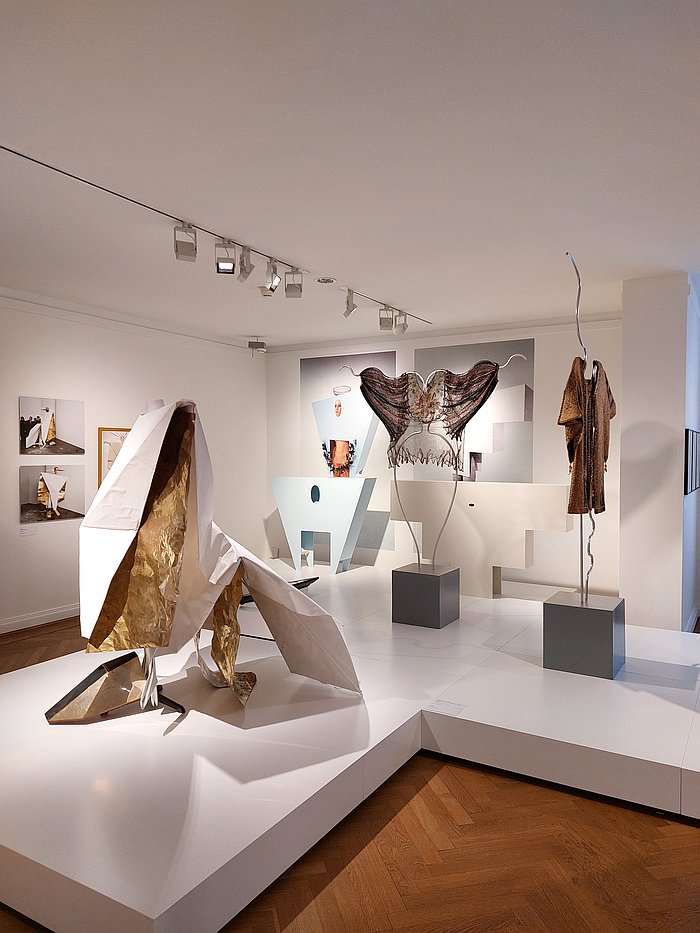
Having taken you through the chronology of Alchimia, The Revolution of Italian Design subsequently allows you to dive deeper into selected thematic areas, selected arenas in which Alchimia and its protagonists, moved, disrupted, influenced, including, for example, Fashion a.k.a. Clothing, as represented by, for example, 1982's Arredo vestivio / Il mobile vestiario, a collection for Fiorucci, themselves a highly influential, and instructive, 1980s Italian platform, which translated furniture design as clothing design, saw sideboards become dresses, or Anna Gili's robe Nulla, an object crafted from cotton and sheet brass which produced noise, a lot of noise, when the wearer moved, as can be appreciated in the short film of Gili performing in Nulla; La Città Alchimia with its reflections on the architectural projects proposed and realised by the platforms protagonists — a great many of whom were trained architects for all that they often worked across genres, inarguably an aspect of the position that "for Alchimia you never have to know if you are practising sculpture, architecture, painting, applied art, theatre or anything else" — including, for example, Casa della Felicità in Omegna on the banks of Lago d'Orta, Pensione Ideale with its thoughts on buildings for tourist/tourism on the Riviera Romagnola in north east Italy, or Groninger Museum, Groningen, a work, that, as one learns, started as an Alchimia project before internal conflicts saw it completed by the fascinating, terrifying, invigorating, quartet of Alessandro Mendini, Philippe Starck, Michele de Lucchi and Coop Himmelb(l)au; The Exhibitions, Alchimia organising some 170 in the 16 years of their formal, active, existence, and exhibitions which not only were a key vehicle for Alchimia to present their positions and arguments, but in many regards were the platform's only realistic commercial opportunity, a reminder that the most important furniture designs aren't necessarily the most commercially successful ones; exhibitions whose discussion in The Revolution of Italian Design includes a presentation of 1981's Il Mobile Infinito a project which, as the name implies, was an endlessly variable furniture collection, and which brings us back to transience and temporality as an important element of the positions of certain factions of the 1970s and 80s avant-garde. And exhibitions which have helped inform exhibition design as much as Alchimia's projects have informed product and spatial design.
Or Decorism, the decoration, ornamentation, we promised to return to.
A decoration, ornamentation, that, famously, for an Adolf Loos was an indicator of a less advanced civilisation, a rise in contemporary decoration, ornamentation, being for Loos an indicator of a cultural step backwards. A position that while it wasn't necessarily always accepted as brutally as Loos formulated it, does find a strong echo in the decoration, ornamentation free Functionalist Modernism architecture and design of the 1920s and 30s.
A period that correlates to, or more accurately an ex-post argument can be constructed that it correlates to, a Louis H. Sullivan's 1892 demand that "we should refrain entirely from the use of ornament for a period of years, in order that our thought might concentrate acutely upon the production of buildings well formed and comely in the nude"4: a period of abstinence, a period of concentration on questions of form, Alchimia rudely ended with the Banal Design collection and its prominent use of decoration, ornamentation. A placing of decoration, ornamentation at the centre of the Banal Design collection, that, as can be understood in the course of The Revolution of Italian Design, was an early statement of a placing of decoration, ornamentation, at the centre of Alchimia's argumentation; in near every chapter of The Revolution of Italian Design one is confronted by decoration, ornamentation.
A decoration, ornamentation that is particularly interesting in Carla Ceccariglia's cycling clothing, Bruno Gregori's design for shoes and a hat, and Giorgio Gregori's proposal for a motorbike, works whose application of decoration, ornamentation reminds very much of, very much finds an echo in, the 1940s Camouflaged series and Gesichter des Krieges series by Xanti Schawinsky as presented in Play, Life, Illusion. Xanti Schawinsky at Kunsthalle Bielefeld, two series that, arguably, are themselves echos of an Alexander Calder's contemporaneous sculptural work. And a Schawinsky also very present in Anna Gili's 1986 Make-Up for A. Guerriero. And thereby allowing one to better appreciate that much as the present is but a poorly definable moment between the past and the future, so to is and was Functionalist Modernism a poorly definable moment between pre- and post-. And was never something intended to remain motionless, was never something intended to remain trapped in time.
Nor was Alchimia.
The risk that Alchimia becomes motionless, trapped, is however very real. Very omnipresent.
And that thanks in no small measure to the decoration, ornamentation, Alchimia placed at the centre of their practice.
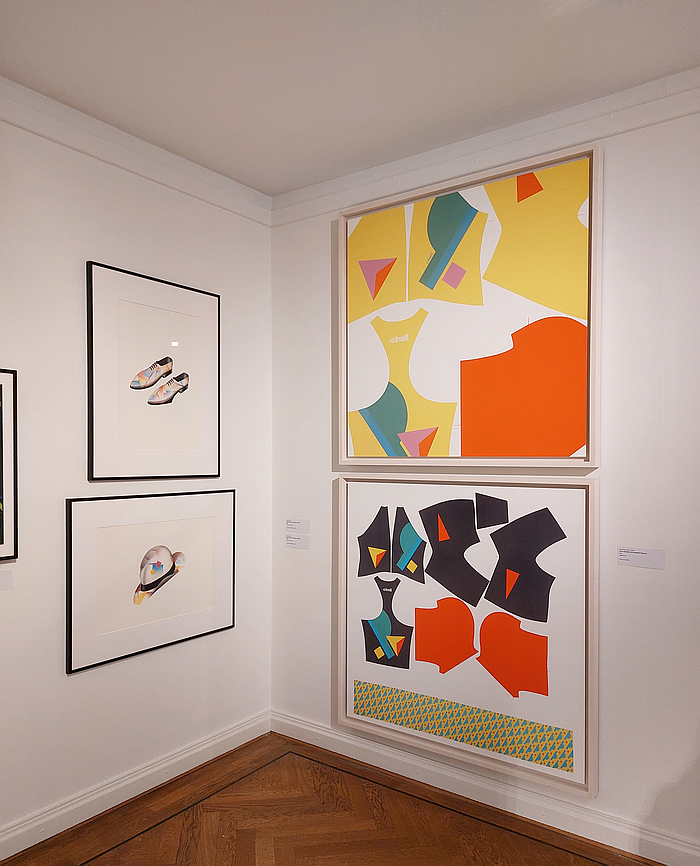
A decoration, ornamentation, that, much as steel tube and white cubes have become placed at the centre of the viewing of the Bauhauses, have become key foci of the contemporary mythologising, objectification, of the Bauhauses as components of architecture and design of the 1920s and 30s, is unquestionably a key foci of the mythologising, objectification of Alchimia as a component of architecture and design of the 1970s and 80s, has become placed at the centre of the viewing of Alchimia and their contemporaries. Is that thing all focus on. A contemporary superficial, objectified, viewing of the works of the Alchimisti, that, as with all superficial, objectified, viewings, tends to block one's approach to the subject, tends to block one's approach to Alchimia, their works, their relevance and their legacy. And by extrapolation tends to deny Alchimia their place in the now and the future.
An Alchimia who, by their own definition, "lavora sui valori considerati negativi, della debolezza, del vuoto, dell’assenza e del profondo, oggi intesi come cose laterali rispetto a ciò che è esteriore, pieno e violento, come cose da rimuovere", 'works on the values considered negative, of weakness, of emptiness, of absence and of the profound, today understood as things oblique to what is external, full and brutal, as things to be removed', who work with kitsch, with embellishment, with Arte Povera, without the academic of the past, an Alchimia who work with a visual aspect that "wins over the cultural root" and is ""detached" from the anthropological and ritual weight of the artist", a visual aspect that much as Pointillism hid the landscape it portrayed and thus forced you to look in more detail, demands you engage with the object, the function of the object, the reason for the object's existence, your personal relationship with the object etc, rather than on epochs, names, reputations, cathedrals, et al. And that not least by way of helping individuals locate themselves in an "epoca di transizione", 'transitional era' characterised by 'the disappearance of many values considered certain' where 'men and women live in a state of turbulence and imbalance' and 'immersed in an indefinite fear'.
¿Sound familiar?
Or perhaps more accurately, has it not sounded familiar to ever changing groups of us during every decade since 1976? Is it not time we learned to view society less from our own perspective and more as the mix of perspectives it is and always was. Stopped considering somethings strong, desirable, other things weak and 'to be removed' and focussed on the questions at hand rather than the uniform they wear?
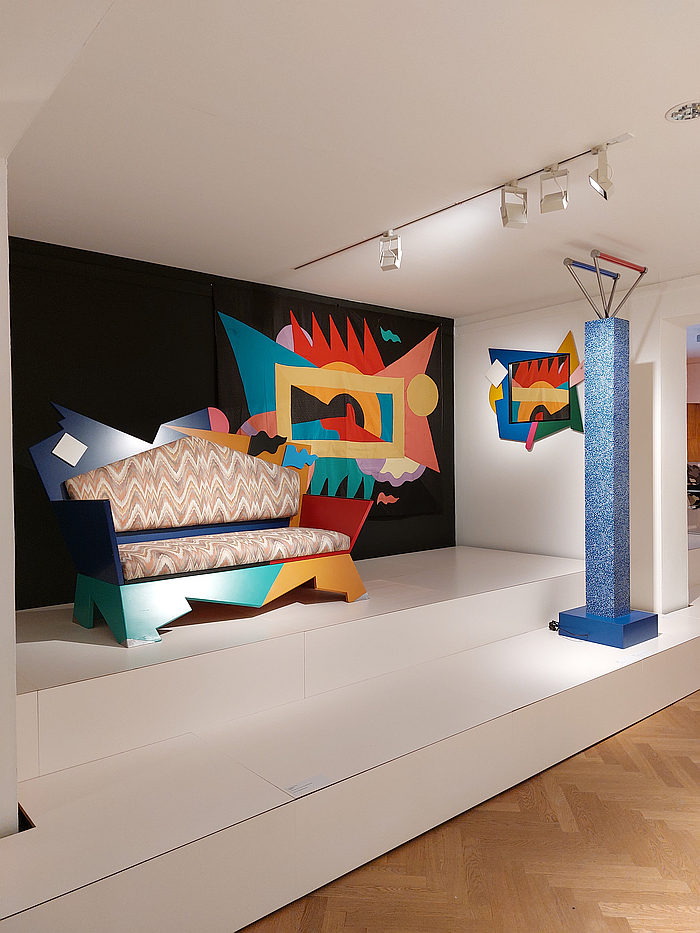
Works where "la "bellezza" dell’oggetto", 'the "beauty" of the object' isn't the decoration, ornamentation, that is the popular focus of the Alchimia cannon today, isn't the decoration, ornamentation, that today is added to untold vapid attempts to cash in on a popular superficial reading of the works of platforms such as Alchimia, vapid attempts to cash in on 'Postmodernism' by reducing it to decoration, ornamentation, without questioning why the decoration, ornamentation, much as those attempts to cash in on Functionalist Modernism through a vapid use of tubular steel and white cubes ignore the whys and wherefores; rather for Alchimia, "la "bellezza" dell’oggetto" 'consists in the love and magic with which it is proposed, in the soul it contains', a 'soul' and 'love' the commercial appropriations can never possess. Which is why they feel so hollow, unfulfilling, fraudulent. An argument which brings us back to a Louis H. Sullivan and his argument that if the results of architecture, and we'll extrapolate to design, are to be signifiant, meaningful, to be things we can relate to, individually and collectively, so must the reason for their genesis, that "it matters then greatly what is the prior inclination of the mind, as much so indeed as it matters what is the inclination of a cannon when the shot is fired".5 Which is also just the most delicious play on the word 'inclination', and a reminder that building with words is a skill akin to building with bricks.
And a position on the soul as beauty, of honesty as beauty, that is surely a lesson that is always worth learning. And definitely worth learning in an age 'of turbulence and imbalance'.
But a lesson that requires first learning to view beyond the superficial, beyond the camouflage, beyond the visuals.
The Revolution of Italian Design is a good place to start leaning to do that.
A good place to, and returning to Sullivan for a third time, an act for which we make no apologies, we all should read a lot more Sullivan than we do; a Sullivan who opines that as one delves deeper and deeper into a work the thus achieved "mental and emotional gratification" leads you on ever deeper until, "we fully learn what was obvious was least, and what was hidden, nearly all"6. Another valuable lesson these days of ours.
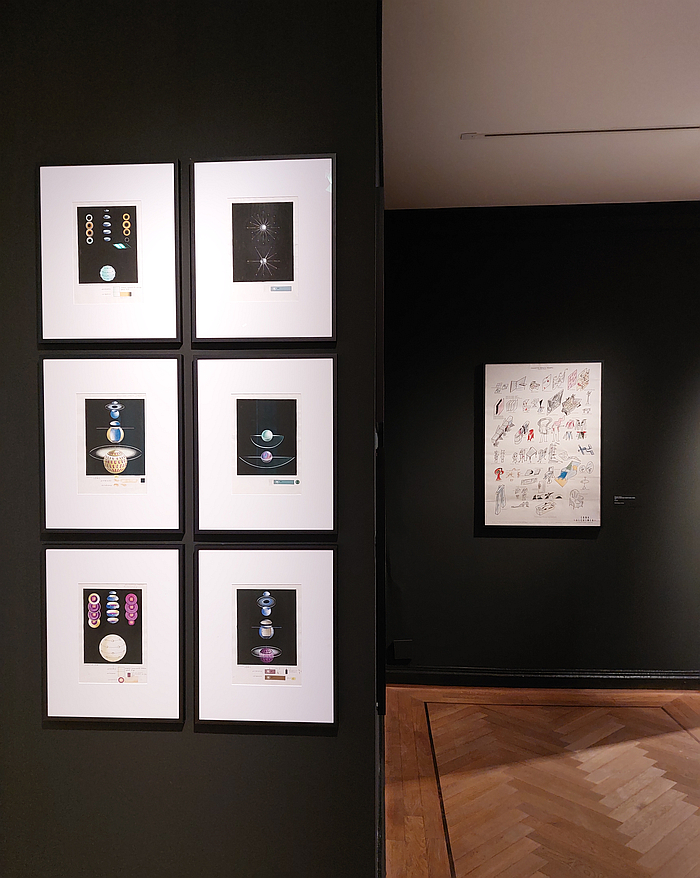
A sprightly paced exhibtion, without ever feeling rushed, or over abbreviated in the name of maintaining tempo, The Revolution of Italian Design provides not only for a succinct but expansive introduction to Alchimia as a platform, as a moment on the helix of creative (hi)story, a locating greatly aided and abetted by the inclusion of the aforementioned introduction to Italian Radicalism and also by the not yet mentioned introduction to Memphis that, arguably, much more popularly known platform, even more mythologised platform, that arose after Alchimia and that as The Revolution of Italian Design allows one to effortlessly appreciate was very much dependent on Alchimia for its genesis. Simply couldn’t have happened without it.
An introduction that underscores how important Alessandro Mendini was for both the establishment and the subsequent development, conceptually and practically, of Alchimia, and thereby allows a differentiated perspective from which to approach Mendini's work and legacy; but that also underscores that Alchimia was a lot more than Mendini. Underscores it was a collective platform. Aside from the Guerriero siblings who, as one can appreciate in the 2010 film Santa Alchimia by Marco Poma that runs on constant loop in an abridged 2025 edit, were driving forces, encouraging all their collaborators to explore the "grandi spazi liberi" with a questioning, open-ended, devil-may-care spirit akin to that with which a Nils Holger Moormann once led the collaborators of his eponymous platform, and an attitude, a distaste for rules and conventions and AI market analysis predictions, which the contemporary furniture industry needs a lot, lot, lot, more of, The Revolution of Italian Design also underscores the importance of the likes of, and amongst others, Andrea Branzi, Giorgio Gregori or the photographs of occhiomagico a.k.a Ambrogio Beretta and Giancarlo Maiocchi in the rise, development and establishment of Alchimia.
An occhiomagico in whose photos one finds, arguably, the majority of the females in the Alchimia story as told by The Revolution of Italian Design, certainly if one temporarily ignores the clothing works. Albeit females invariably naked. At least partially. Often fully. Thus a further expansion of Guerrilla Girls' position that women need to be naked to get into museums beyond 4 Museums – 1 Modernism at the Pinakothek der Moderne, Munich's, that women need to be naked to get into exhibitions exploring the rise and development of Modernism, to women need to be naked to get into Alchimia, need to be naked to get into exhibitions exploring architecture and design post Modernism. Unless that is they design clothes. Which may or may not be ironic. Then there's the more than suggestive scissors by Allen Jones, an object that stands very neatly in Jones' wider canon with its numerous works either offensively objectifying women or highlighting an inherent misogynist exploitation of women in contemporary society. The choice of interpretation is yours. As is the path your thoughts take on women and design and architecture in 1970s and 80s Italy following your visit to The Revolution of Italian Design. But a thought process you must initiate.
And an occhiomagico whose avant-garde compositions and methodologies allow access to appreciations of the importance and influence of developing computer technology, and the thereby enabled new multi-media possibilities, new visualisations of the world around us, enabled, for the processes of Alchimia; new technology that, an argument can be made, and subsequently discussed, enabled new forms of transience and temporality, made the environment in which we exist even less permanent than that our forbearers knew, a process that technology has continued to advance, and will continue to advance.
And a role of new technology one very much discerns from viewing The Revolution of Italian Design that was self-evident for Alchimia, but not at the expense of more conventional technology, or as the 1985 Manifesto proclaims, "for Alchimia, despecialisation is valid, that is, the hypothesis that “confused” methods of conception and production must coexist, where craftsmanship, industry, information technology, current and outdated techniques and materials can mix". A mixing of the current and the outdated, a blending of the old and the new, that can also be understood in the mixing, blending of 'sculpture, architecture, painting, applied art, theatre or anything else' in Alchimia's approach. And in the swathing of the past with the novel inherent in Poltrona di Proust or the two Bau.Haus collections, a novel swathe that for all it alters the existing is very much dependent on it, and must ever extinguish nor mimic it.
Rather, an altering, an equitable mixing of the current and the outdated, that cannot occur, a progression of architecture, design, society that as Alchimia pleasingly elucidate cannot occur, much as a Guerilla Girls, Charles and Ray Eames, Xanti, Schawinsky, Marcel Breuer, Kaare Klint, William Morris, Paul Signac, Louis H. Sullivan et al before them in their own ways elucidated cannot occur, as long as one remains confined by conventions and rules, as long as one is guided by, defined by, interested in, conventions and rules.
Rather is an altering, an equitable mixing, that requires first being aware of and subsequently exploring, embracing, existing in, the "grandi spazi liberi" outwith those conventions and rules that, invariably, are enabled by the novel, be that a tangible, material novel or a intangible, conceptual novel.
Alchimia. The Revolution of Italian Design is scheduled to run at the Bröhan Museum, Schloßstraße 1a, 14059 Berlin until Sunday September 7th.
Further details can be found at www.broehan-museum.de
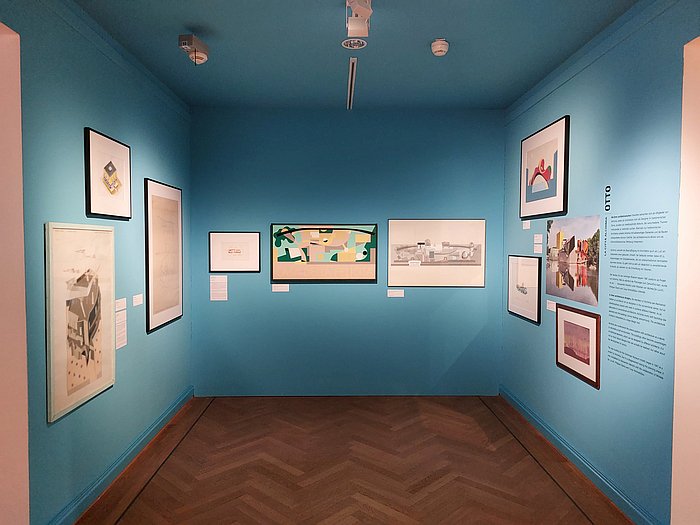
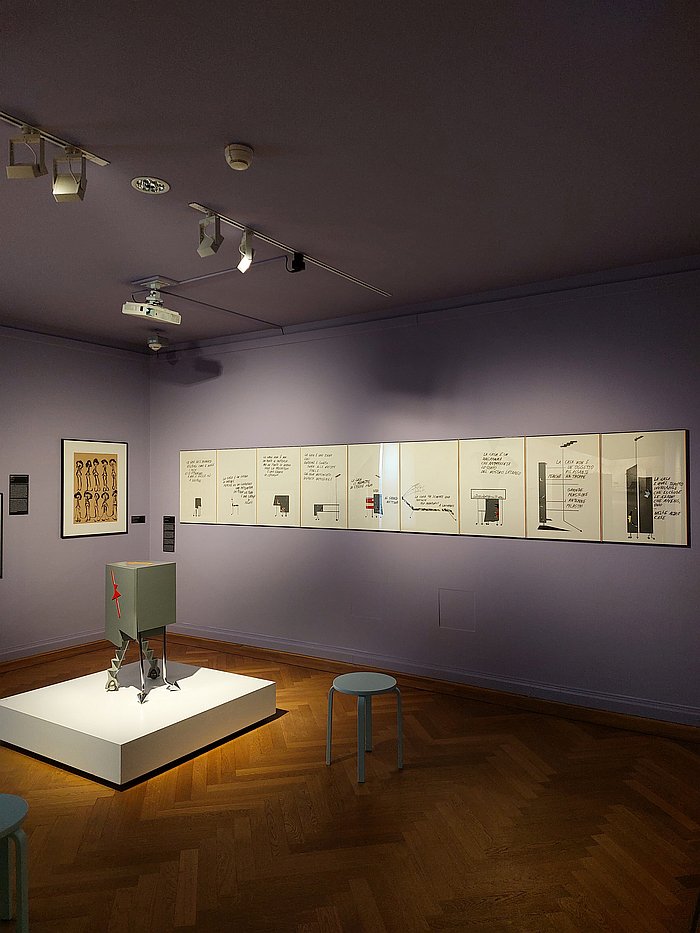
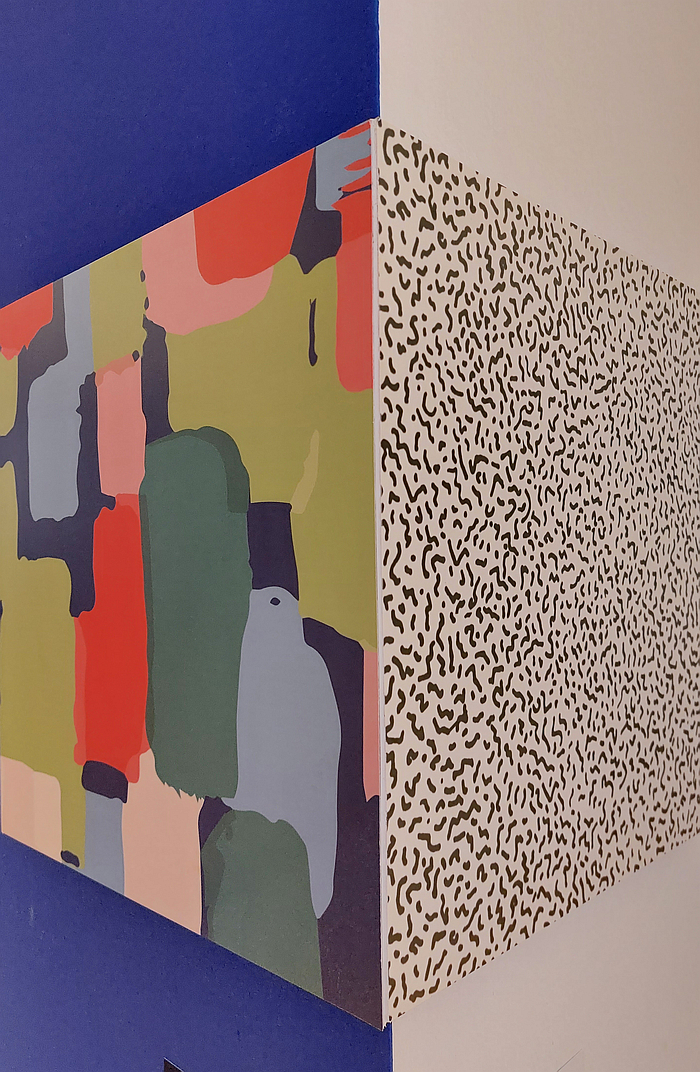
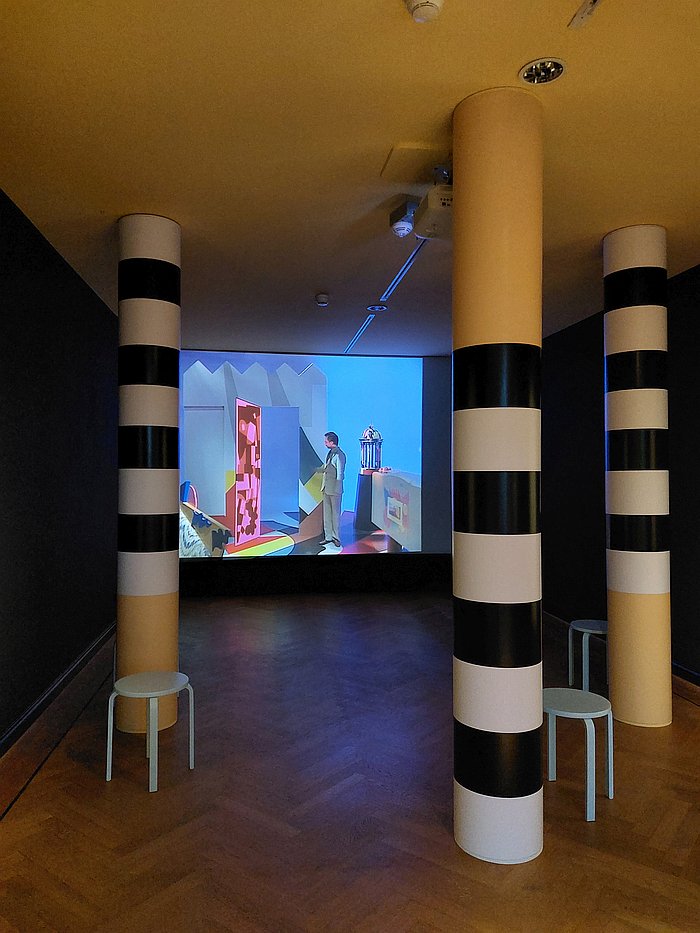
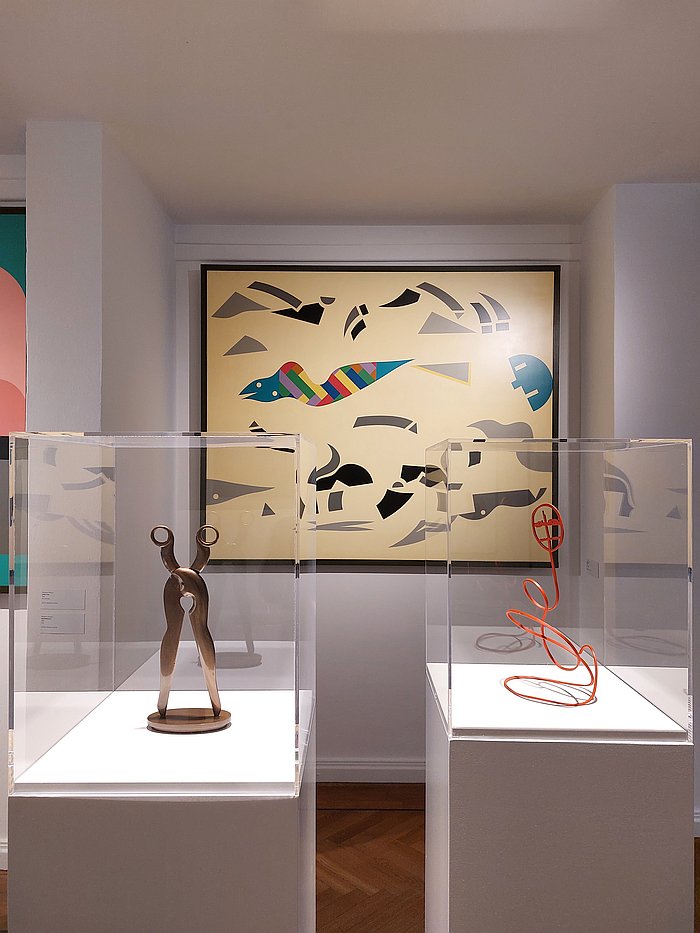
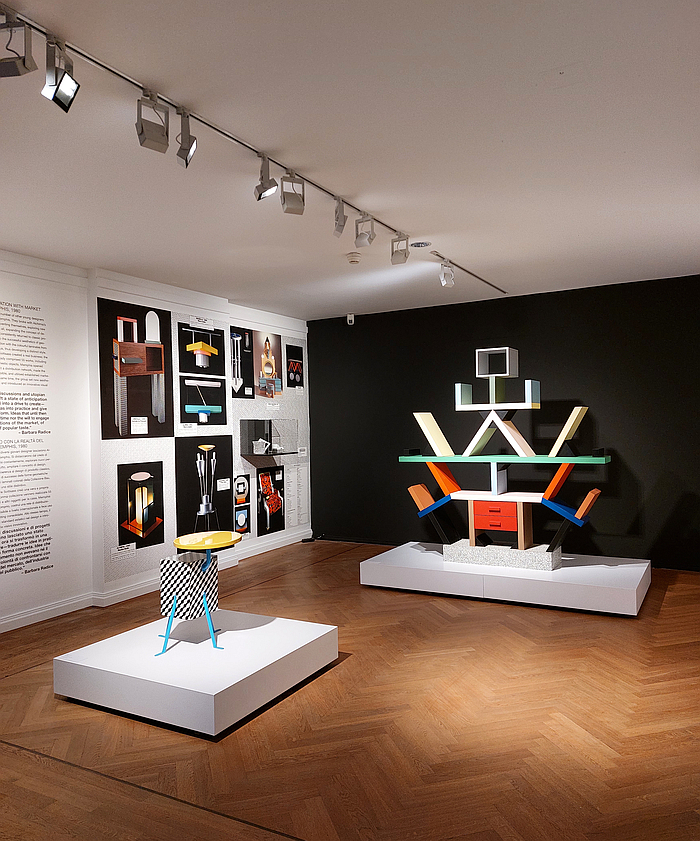
1and all other quotes unless otherwise stated, Alessandro Mendini, Alchimia Manifesto 1985 as presented in The Revolution of Italian Design. Available online at https://atelieralchimia.com/alchimia/
2The Italian verb is designeo, which from a linguistic perspective is a wonderful position from whch to approach the word, the concept of design
3Kaare Klint, Undervisningen i Møbeltegning ved Kunstakademiet, Arkitekten månedshæfte, October 1930, page 203
4Louis H. Sullivan, Ornament in Architecture, The Engineering Magazine, reprinted in Louis H. Sullivan, Kindergarten Chats and Other Writing, Dover Publications, New York, 1979, page 187 In the interests of fairness and completion Sullivan makes his demand in interest of "our aesthetic good" i.e. his focus was visuals we're arguing Alchimia moved beyond. But a focus on visuals which, we'll argue, in no way negates using Sullivan's contribution to the discussion at hand.
5ibid, page 188
6ibid, page 189